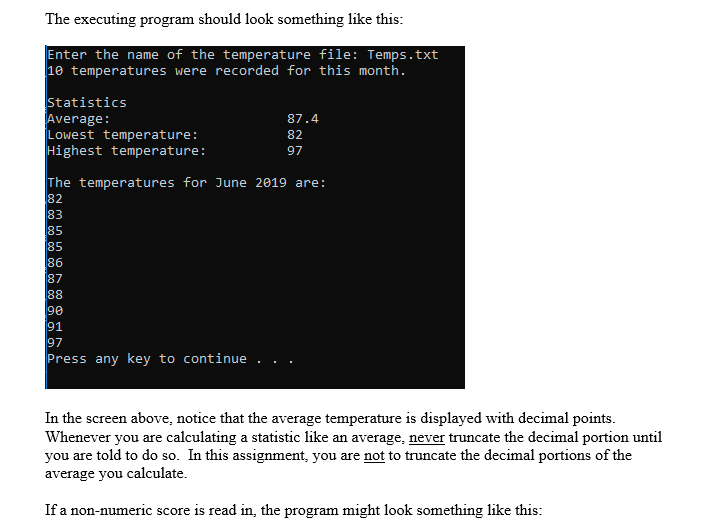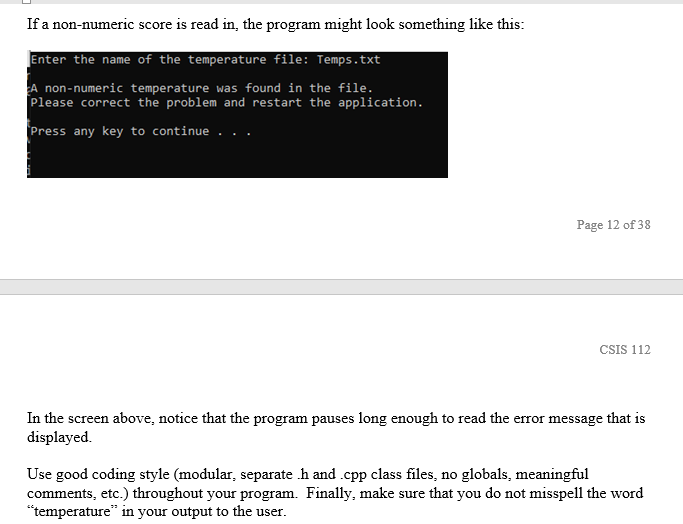Question
Sort Temperatures Lab This assignment utilizes a class in an application that might be useful in the real world. It requires the sorting of, and
Sort Temperatures Lab
This assignment utilizes a class in an application that might be useful in the real world. It requires the sorting of, and computation with, data involving temperatures.
Requirements:
You are working for a meteorologist to maintain a list of temperatures and some related statistics for a month.
Class and Data members:
Create a class called Temperature that stores temperature readings (integers) in a vector (do not use an array). The class should have data members that store the month name and year of when the temperature readings were collected.
Constructor(s):
The class should have a 2-argument constructor that receives the month name and year as parameters and sets the appropriate data members to these values.
Member Functions:
The class should have functions as follows:
- Member functions to set and get the month and year variables.
- A member function that adds a single temperature to the vector. Both negative and positive temperatures are allowed. Call this function AddTemperature.
- A member function to sort the vector in ascending order.
Feel free to use the sort function that is available in the algorithm library for sorting vectors.
Or, if you would prefer to write your own sort code, you may find this site to be helpful:
http://www.cplusplus.com/articles/NhA0RXSz/
- A member function to compute the average (x) of the temperatures in the vector. The formula for calculating an average is
x = xi / n
where xi is the value of each temperature reading and
n is the total number of temperature readings in the vector.
- A member function to determine the lowest temperature for the month. [Note that to receive credit for this function, it must contain an algorithm to search through the vector to determine the minimum value. You cannot simply sort the vector and return the first data member.]
- A member function to determine the highest temperature for the month. [Note that to receive credit for this function, it must contain an algorithm to search through the vector to determine the maximum value. You cannot simply sort the vector and return the last data member.]
- A member function to return the number of temperatures that were read in for the month.
- A member function to display the sorted temperatures.
Write a program (client) that uses the class by creating a Temperatures object and prompting the user for a file name. Appropriate error checking is required to ensure that the file exists and can be opened successfully.
The client should read in the file contents and store them in the object. The file will be formatted such that the first line contains the month name, the second line contains the year, and each successive line contains a temperature. A typical input file might contain:
June
2019
90
85
97
91
87
86
88
82
83
85
Note that the file may contain any number of temperatures for a given month. Therefore, you need to read in and store each temperature until you reach the end of the file.
The client (i.e. main()) should read in the contents of the file. After each temperature is read in, it should call the member function in the Temperatures class to add the new temperature (i.e. one temperature at a time) to the vector.
Main() should then produce a report that displays the month and year of the data, the total number of observations (temperatures) in the file, the lowest temperature, the highest temperature, the average temperature, and finally, a listing of all of the temperatures that were read in. The listing of all of the temperatures must be displayed in sorted order (ascending from lowest to highest).
All output should be labeled appropriately, and validity checking should be done on input of the filename and also the temperatures that are read in.
If a non-numeric value is encountered in reading in the temperatures, the program should output an error message indicating that a non-numeric value was found in the file, and the entire program should then terminate. If a non-numeric is found, consider the entire file to be corrupted and dont try to produce any calculations nor display the contents of the vector just end the program with an appropriate error message. (Make sure the error message is displayed long enough for the user to read it before ending the program.) Again, negative temperatures are permitted, but non-numeric temperatures should be caught.


Step by Step Solution
There are 3 Steps involved in it
Step: 1

Get Instant Access to Expert-Tailored Solutions
See step-by-step solutions with expert insights and AI powered tools for academic success
Step: 2

Step: 3

Ace Your Homework with AI
Get the answers you need in no time with our AI-driven, step-by-step assistance
Get Started


